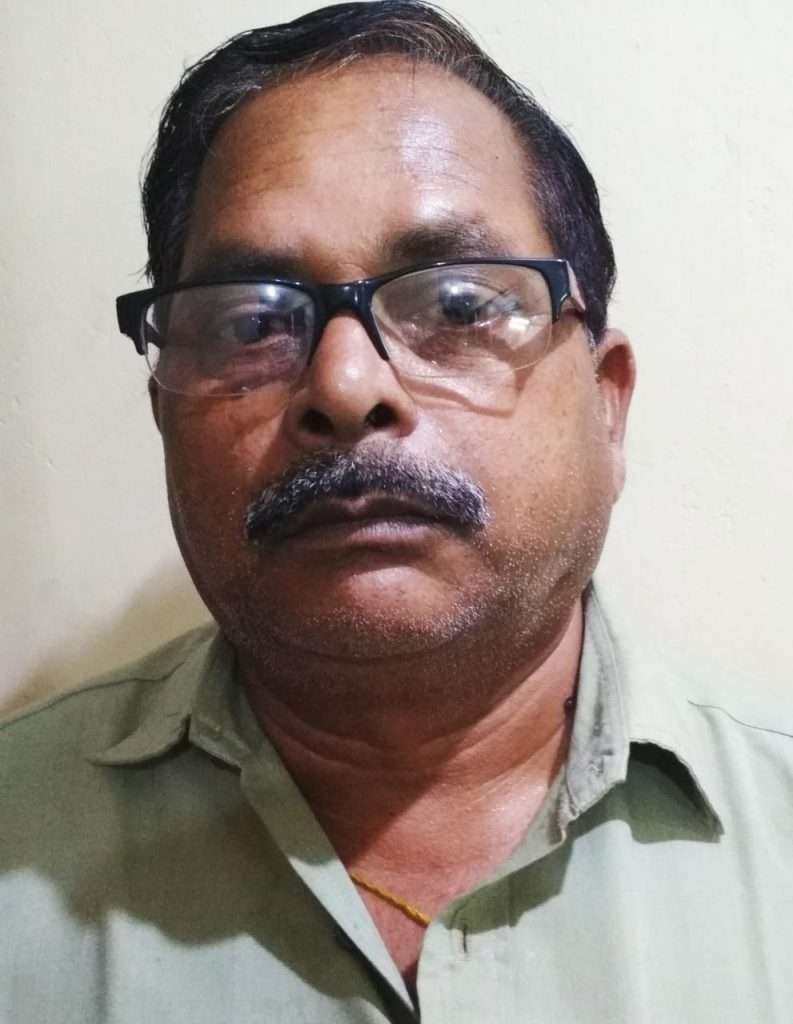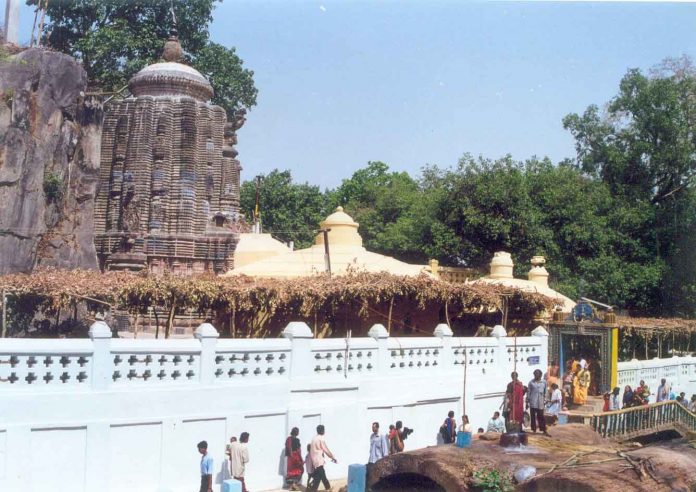- The Nrusinghanath temple of Paikmal is a place of pilgrimage in the Padampur sub division of erstwhile undivided Sambalpur district on the northern flank of Gandhamardan Hills situated about 32 kms south west of Padampur and 3 Kms from Paikmal.
This is a temple dedicated to Lord Vishnu in the form of MarjaraNrusingha – the face is like that cat and the body like that of a lion. It is a papa mochanakshetra (a shrine for release of sins). Lord Shiva was liberated from Go-hatya (cow slaughter) by bathing here. There are some archaeological remains of Ramayan and Mahabharata era here. It is believed that during the time hanuman was carrying Gandha-mardanparbat to save the life of Laxman who had been hurt by Indrajeet’s shakti, a portion of the mountain fell here near Paikmal. Still there are some medicinal plants on this mountain.
In the Puranas it is mentioned that there was a rishi named Udanga. He had a daughter ‘Malati’, who was very very beautiful. Attracted by her beauty, Ravana, king of Lanka made sexual intercourse with her. Later, a mouse also intercoursed her. As a result, a musika-daitya (mouse-demon) was born from her. After birth Musikadaitya devoured her mother Malati.
In the later years musikadaitya propitiated Lord Shiva and got boon by which he became stronger and started atrocities on Swarga, Martya and Patala. So, Gods petitioned before Lord Vishnu to save them. On the prayer of Gods, Vishnu chased musika-daitya to kill him. The demon ran away and entered in a hole of Gandhamardan mountain. The Lord Vishnu took the form of Cat and waited near the hole to kill musika-daitya when it will come out. Till date the demon has not come out and Lord Vishnu is waiting for him to kill. On this particular spot Nrusinghanath Temple stands and MarjaraNrusinghanath is being worshipped.
This temple was constructed by the fourth Chauhan king of Patna – Vaijjala Dev-I in the year 1413 A.D. The British archaeologist J. D. Beglar has given a description of this temple. His description may be reproduced here:
“The tirtha is at the source of papaharininala (a tributary of the river Anga), at the point where it leaves the hills after numberless cascades. It rises at the top of the hill and is said to first see the light at the foot of a large mango tree, where it bubbles forth from a spring. It soon increases in volume by various additions and descends the west slope of the hill in a series of cascades and rapids some of which (three) are very high up, and of some height, the third cascade being distinctively visible from a distance of fully 10 miles with the naked eye, and probably from a greater distance. The temples are situated at the point where it finally leaves the foot of the steep hill and starts on its way fairly in the undulating plains. The temples are neither very large nor very remarkable, though sufficiently so for this part of India.
The most important temple is tolerably large one in the Khajuraho style, once very elaborately sculptured inside and out, but having fallen into decay, has been repaired with a liberal allowance of plaster, which covers up everything. The Mahamandapa, which, however, I was not allowed to enter, has three entrances and so far is an improvement on the Khajuraho style. These entrances are about the only external portions of the temple not buried in plaster; they are small but elaborately structured. All round the tower of the sanctum are rows of statues as at Khajuraho, but these rows of statues are not continued on to the Mahamandapa, which on this account, as well from a certain want of proportion (so far as I could judge by the age, for I was not allowed to measure), to the sanctum, I consider to be a subsequent addition, the original one having most probably fallen down. The Mahamandapa is supported internally on pillars, which are well carved and apparently old, so far as I could judge looking at them from outside the entrances”.
The inscription on the temple is in transitional Oriya characters, very closely approaching modern Oriya. It mentions Bachha Raja of Patna and Bijal Raja, his son and records the gift of the village of Loisinga. It is dated, but here is the puzzle. The date is either 672 or 728, which is utterly inconsistent with the forms of the characters if referred to either the Saka or the Vikrama eras. I am, therefore, inclined to consider it as a Hijra date, for it was no uncommon thing to use the Hijra or Fasli date all over Bengal down to so late as a score of years ago, and there is nothing improbable or impossible in its having been used elsewhere also, it being clearly the recognized official era. If then we consider it as the Hijra, all difficulties are cleared away for the form of the characters and the character of the architecture both agree with the date.
The English translation of the Oriya script is as below –
“Vaijala deva, son of Vatsaraja deva, the Raja of Patna caused the erection of the temple on the hillGandhamardana and presented a necklace of precious stones along with 100 cows to the God VidalaNarasimhanatha. He also granted to the priest of the temple for maintenance of worship some lands situated on the locality known as Adimerada and Varilonala and mango grove known as Rapanga lying in the vicinity of Loisinga. The gift was made on Friday, the full moon day of Chaitra, the moon remaining in the Hasta Nakshatra in the year Vikari. The object of the donor in making the gifts was to have a son through propitiation of God. The text was composed by Agha”.
This is the first Vaishnavite temple in western Odisha. It is dedicated to Lord Vishnu. Here it is tradition that unmarried priests worship the presiding deity. Every year in the last week of the month of Vaishakha, a fair is organized. It is called Vaishakhi Mela. Large numbers of pilgrims congregate here.
There are many important sites here of historical and religious significance –
- The tree of Satya Amba relating to Dwaparayuga.
- Saptadhara – the meeting point of seven springs of water source.
- Kapila dhara – It was said to be the hermitage of Sage Kapila.
- PanchaPandavaGhat – During their exile Pandavas stayed here for some time.
- TridevGhat – relating to Brahma, Vishnu and Maheswar.
- PitrupindaGhat – Here ancestors are given pindas.
- Kaka Kunda – It is like Ganga, the liberator of soul.
- Sita Kunda – relating to Ramayan
- Bhima Dhar – in the name of one of the Pandava princes.
- Chala Dhar – It is a cascade of 10 ft. height and is said to be pure for bathing for physical fitness and material prosperity.
- Ganapati Ghat – bathing here is to be immortal.
- Garuda pillar – In honour of Lord Vishnu
- Kabir Mandap – It is said that the saint Kabir came here and had sojourn for some time.
- GokundaGhat – the site where Lord Shiva bathed and became released from Go-hatya (cow slaughter)
So, the Nrusinghanath temple of Paikmal is one of the holiest places of India. Moreover, Narasinghanath has always drawn the attention of scholars of different disciplines such as History, Sociology, archaeology, art, culture etc. because of various pieces of evidence discovered here.
Now we may conclude the essay by knowing the Bija mantra of Nrusinghanath:
“ Om
Ugraveeram Mahavishnum
Jwalanto Sarvatomukham
Nrusingham Veeshanam Bhadram
Mrityum Mrityum Namamyaham”.
(The views expressed are the writer’s own.)

Radhakanta Seth is an Income tax officer in Sambalpur. He is a freelance writer and his articles have been published in some Oriya dailies like Sambad, Samaj, Dharitri, and English dailies like The Telegraph and in a sociological journal ‘Folklore’ published from Kolkata.
He can be reached at [email protected]

